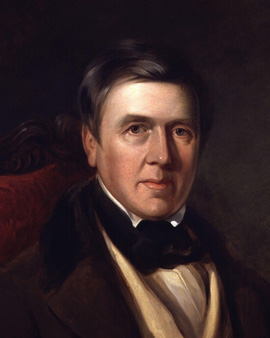The 18th century was the Golden Age of English watercolour painters. The series of great names, such as Joseph Mallord William Turner and Francis Towne, includes Birmingham-born David Cox. Born the son of a blacksmith, he financed his studies of watercolour painting by painting backdrops. Cox learned to paint flowing watercolours and used the transparent painting technique to depict the changing light of English landscapes. David was an artist and scholar. He passed on his knowledge in books and to art students.
David Cox was a typical representative of Romanticism, and at the same time paved the way to Impressionism with his landscape painting. The watercolor "Beach Scene at Sunrise" shows the landscape in the rose-colored light of the rising sun. The artist's subjective impression speaks increasingly from the landscape depictions. In contrast, his works from interiors, such as the cycle of the Long Gallery in Derbyshire, appear colour-intensive, realistic and always with the natural play of light and shadow in space.
In the second half of his life, David Cox devoted himself to travelling and exploring Europe. Similar to Turner, he made sketches of his impressions and later put the landscapes on paper. At the advanced age of seventy, Cox turned to oil painting. Perhaps it was due to shaky hands that the artist changed his painting medium. "A Windy Day at the Beach" is one of the most remarkable paintings of his last period.
×





.jpg)
.jpg)
.jpg)
.jpg)
.jpg)
.jpg)
.jpg)
.jpg)
.jpg)
.jpg)
.jpg)
.jpg)
.jpg)
.jpg)
.jpg)
.jpg)
 - (MeisterDrucke-240168).jpg)
 - (MeisterDrucke-240168).jpg)
.jpg)
.jpg)
.jpg)
.jpg)
.jpg)
.jpg)
.jpg)
.jpg)
.jpg)
.jpg)
.jpg)
.jpg)
_-_(MeisterDrucke-590320).jpg)
_-_(MeisterDrucke-590320).jpg)
.jpg)
.jpg)
 - (MeisterDrucke-167580).jpg)
 - (MeisterDrucke-167580).jpg)
 - (MeisterDrucke-73134).jpg)
 - (MeisterDrucke-73134).jpg)
.jpg)
.jpg)
.jpg)
.jpg)
.jpg)
.jpg)
.jpg)
.jpg)
.jpg)
.jpg)
_-_(MeisterDrucke-1466709).jpg)
_-_(MeisterDrucke-1466709).jpg)
.jpg)
.jpg)
_-_(MeisterDrucke-896717).jpg)
_-_(MeisterDrucke-896717).jpg)
.jpg)
.jpg)
.jpg)
.jpg)
_-_(MeisterDrucke-1105312).jpg)
_-_(MeisterDrucke-1105312).jpg)
.jpg)
.jpg)
.jpg)
.jpg)
.jpg)
.jpg)
.jpg)
.jpg)
.jpg)
.jpg)
.jpg)
.jpg)
.jpg)
.jpg)
.jpg)
.jpg)
.jpg)
.jpg)
.jpg)
.jpg)
.jpg)
.jpg)
.jpg)
.jpg)
.jpg)
.jpg)
.jpg)
.jpg)
.jpg)
.jpg)
.jpg)
.jpg)
.jpg)
.jpg)
.jpg)
.jpg)
_-_(MeisterDrucke-1129024).jpg)
_-_(MeisterDrucke-1129024).jpg)
_-_(MeisterDrucke-1129458).jpg)
_-_(MeisterDrucke-1129458).jpg)
_-_(MeisterDrucke-1103088).jpg)
_-_(MeisterDrucke-1103088).jpg)
.jpg)
.jpg)
.jpg)
.jpg)
_-_(MeisterDrucke-1094329).jpg)
_-_(MeisterDrucke-1094329).jpg)
.jpg)
.jpg)
_-_(MeisterDrucke-1130653).jpg)
_-_(MeisterDrucke-1130653).jpg)
.jpg)
.jpg)
.jpg)
.jpg)
.jpg)
.jpg)
_-_(MeisterDrucke-1127068).jpg)
_-_(MeisterDrucke-1127068).jpg)
.jpg)
.jpg)
.jpg)
.jpg)
_-_(MeisterDrucke-896663).jpg)
_-_(MeisterDrucke-896663).jpg)
_-_(MeisterDrucke-316312).jpg)
_-_(MeisterDrucke-316312).jpg)
.jpg)
.jpg)
.jpg)
.jpg)
.jpg)
.jpg)
.jpg)
.jpg)
.jpg)
.jpg)
.jpg)
.jpg)
.jpg)
.jpg)
.jpg)
.jpg)
.jpg)
.jpg)
_-_(MeisterDrucke-901921).jpg)
_-_(MeisterDrucke-901921).jpg)
.jpg)
.jpg)
.jpg)
.jpg)
.jpg)
.jpg)
_-_(MeisterDrucke-1087766).jpg)
_-_(MeisterDrucke-1087766).jpg)
.jpg)
.jpg)
.jpg)
.jpg)
.jpg)
.jpg)
.jpg)
.jpg)
.jpg)
.jpg)
.jpg)
.jpg)
_-_(MeisterDrucke-1132448).jpg)
_-_(MeisterDrucke-1132448).jpg)
.jpg)
.jpg)
.jpg)
.jpg)
.jpg)
.jpg)
_-_(MeisterDrucke-566237).jpg)
_-_(MeisterDrucke-566237).jpg)
.jpg)
.jpg)
_-_(MeisterDrucke-896664).jpg)
_-_(MeisterDrucke-896664).jpg)
_-_(MeisterDrucke-1133990).jpg)
_-_(MeisterDrucke-1133990).jpg)
.jpg)
.jpg)
.jpg)
.jpg)
_-_(MeisterDrucke-1171202).jpg)
_-_(MeisterDrucke-1171202).jpg)
.jpg)
.jpg)
_-_(MeisterDrucke-896474).jpg)
_-_(MeisterDrucke-896474).jpg)
.jpg)
.jpg)
.jpg)
.jpg)
.jpg)
.jpg)






